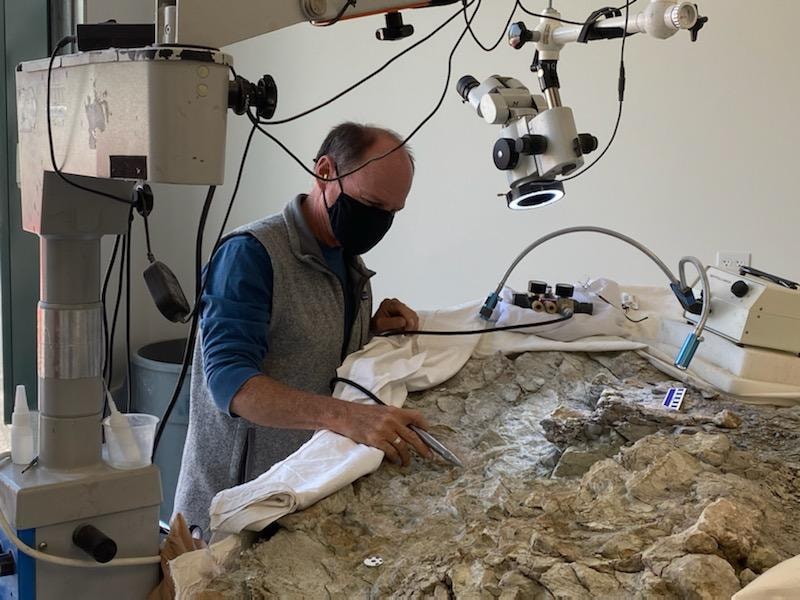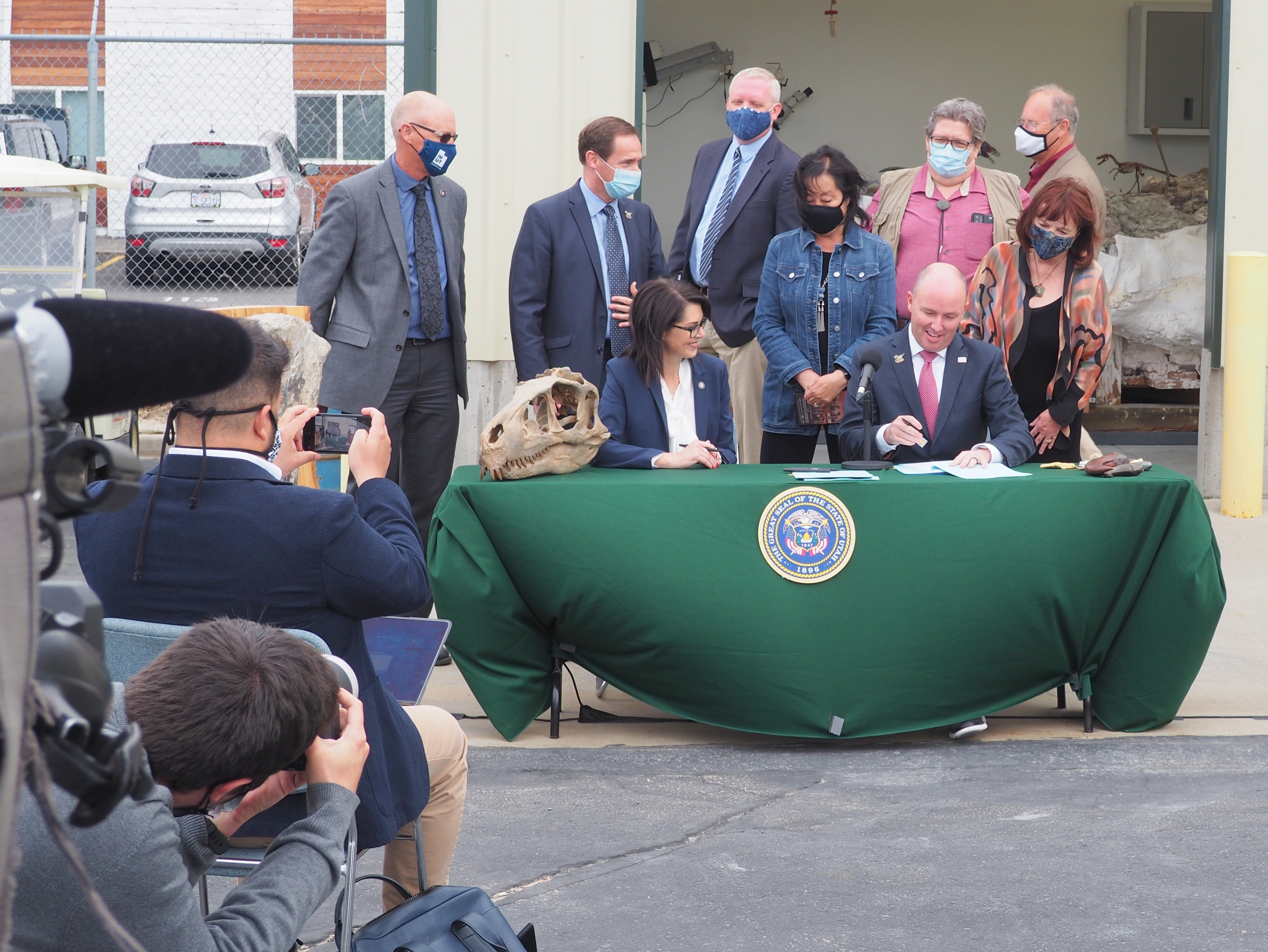Utahraptor Megablock Fossil Project
The Utah Geological Survey (UGS) holds on behalf of the citizens of the State of Utah what is likely the most spectacular dinosaur fossil assemblage ever collected in the state. Recovered from the Stikes Quarry in southeastern Utah, this 9-ton block of sandstone contains thousands of bones of baby to adult Utahraptor dinosaurs, at least two iguanodont dinosaurs, and possibly other species. These animals became trapped in a quicksand-like mass likely while preying on one or more trapped plant-eating iguanodont dinosaurs. Many painstaking hours have been spent by expert preparators carefully exposing hundreds of bones from just a small portion of the accumulation of skeletons. The megablock is yielding numerous juvenile and adult skeletons that will be reassembled into a pack of Utahraptor dinosaurs and displayed at the Natural History Museum of Utah.
Megablock Status
As of the start of 2021, over 3,500 hours of fossil preparation have been completed on the megablock. Most of the work has been done by Scott Madsen who has over 40 years of fossil preparation under his belt and is one of the best preparators of small fossils in the world. Most of the funding to pay Scott has been provided by individual donations using GoFundMe and other funding appeals. In a 2017 article, the New York Times explored the use of crowdfunding to support scientific research featuring the Utahraptor Project. The publicity from this article led a private donor to give over $50,000 in funding.
New Research
Model animation courtesy of Montrose Edmonds.
In addition to fossil preparation, we repeatedly photograph the block to make three-dimensional (3D) models using photogrammetry. These models preserve a record of the position of each bone and will one day be used to generate a 3D map of the entire block. Some of these models can be viewed on the UGS paleontology page on Sketchfab. We are in the process of completing several scientific papers on fossils from the megablock including an adult Utahraptor braincase recovered in 2007. We published a paper in 2016 detailing the geology of the Stikes Quarry and making the case that the animals at the site were trapped and killed in a dewatering feature (essentially quicksand). Some of the adult Utahraptor skull bones from the megablock have been added to the material used in the initial description of Utahraptor from the Gaston Quarry and have also been used to make an updated skull reconstruction. Some of the bones from the block have already been added to the collections of the Natural History Museum of Utah, which is the repository for all of the material from the megablock.
New Research
In addition to fossil preparation, we repeatedly photograph the block to make three-dimensional (3D) models using photogrammetry. These models preserve a record of the position of each bone and will one day be used to generate a 3D map of the entire block. Some of these models can be viewed on the UGS paleontology page on Sketchfab. We are in the process of completing several scientific papers on fossils from the megablock including an adult Utahraptor braincase recovered in 2007. We published a paper in 2016 detailing the geology of the Stikes Quarry and making the case that the animals at the site were trapped and killed in a dewatering feature (essentially quicksand). Some of the adult Utahraptor skull bones from the megablock have been added to the material used in the initial description of Utahraptor from the Gaston Quarry and have also been used to make an updated skull reconstruction. Some of the bones from the block have already been added to the collections of the Natural History Museum of Utah, which is the repository for all of the material from the megablock.
Model animation courtesy of Montrose Edmonds.
History of the Megablock
Preliminary analysis of the 125-million-year-old sandstone indicated the megablock contains the remains of at least one adult Utahraptor, ten juveniles, and three babies; however, upon further investigation, we expect to find more than twice that amount. Preservation within the block appears exceptional, lending to the hope that details such as feather impressions may be preserved. Bones of at least two plant-eating iguanodont dinosaurs were also discovered within the sandstone block, leading Utah paleontologists to believe the Utahraptor dinosaurs were hunting when they became mired in quicksand, buried, preserved, and fossilized. Explore the timeline below to learn how this incredible megablock of fossils was discovered, excavated, and continues to be prepared.
Utahraptor State Park
On April 13, 2021, Governor Spencer Cox held a ceremonial signing of HB 257, which created Utahraptor State Park, located roughly 15 miles northwest of Moab in Grand County. While it is still in the planning process, future park visitors to the area can expect two modern campgrounds, restrooms, office and entrance station, and trailheads for access to the nearby OHV and mountain bike trail systems. The exact size of Utahraptor State Park is still being determined as Utah State Parks works to finalize lease and purchasing agreements with the Utah Division of Forestry, Fire and State Lands, and the School and Institutional Trust Lands Administration. It’s anticipated the park will be between 7,000 and 8,000 acres in size and will contain the Dalton Wells Quarry where over 5,500 bones representing over 10 dinosaur species have been recovered during the site’s 45-year history of excavation and discovery.
Media Gallery
View videos and photos from the journey of the Utahraptor Megablock.


































